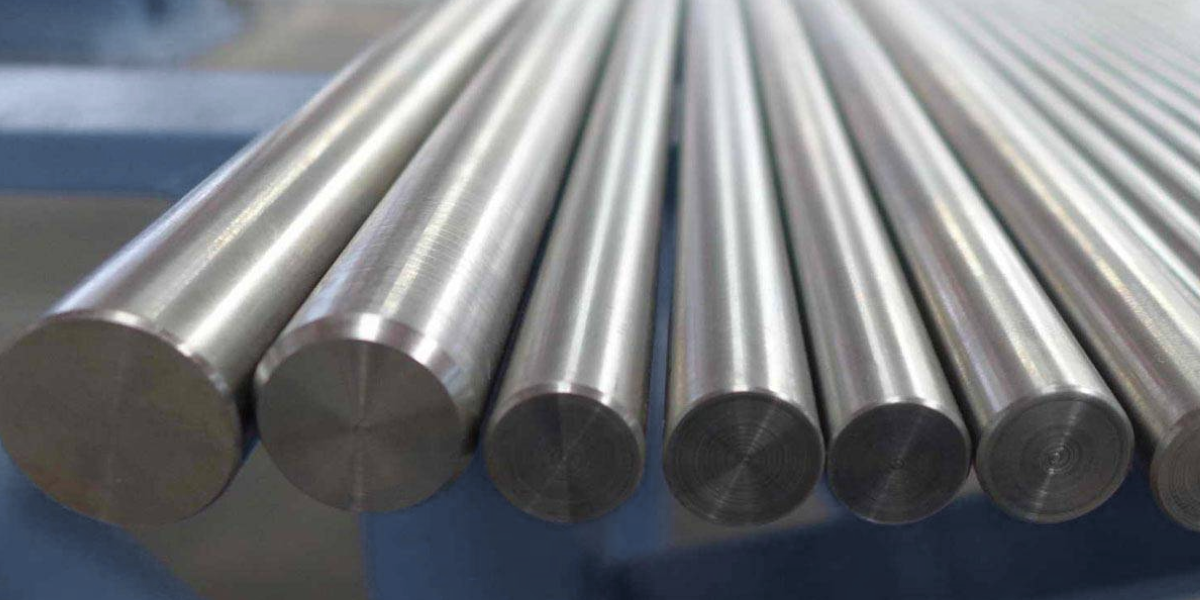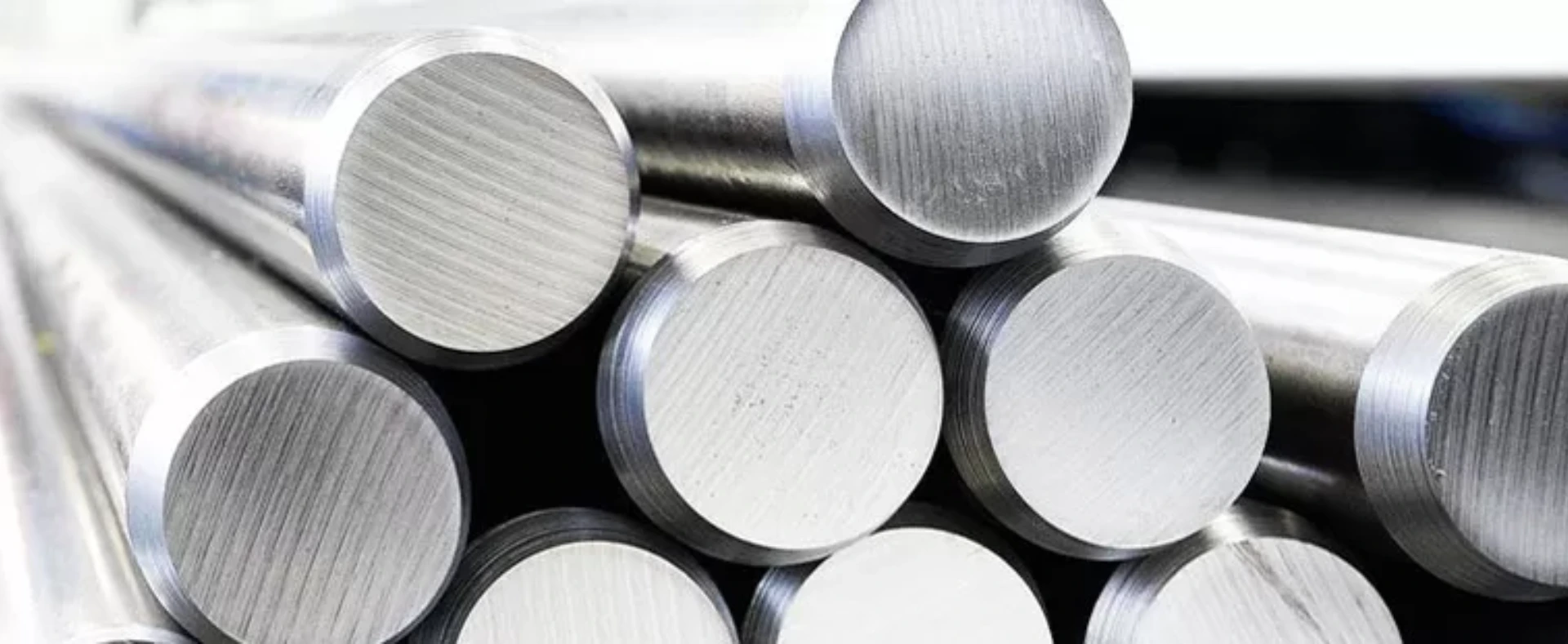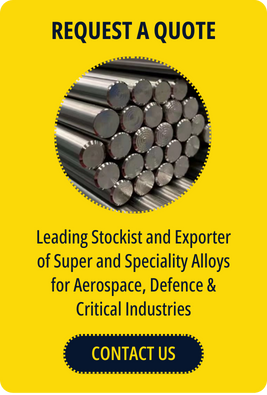Denounce with righteous indignation and dislike men who are beguiled and demoralized by the charms pleasure moment so blinded desire that they cannot foresee the pain and trouble.
Read MoreInconel 617 Supplier and Stockist in India
Leading Inconel 617 Stockist in India. ASTM B166 Inconel 617 Round Bars Supplier, ASTM B168 UNS N06617 Sheets Dealer, DIN 2.4663 Plates Exporter, Inconel 617 Pipes Stockist. Aerospace Grade Inconel 617 Supplier & Exporter in Mumbai, India.
Inconel 617 is a nickel-chromium-cobalt-molybdenum superalloy known for its exceptional strength, oxidation resistance, and excellent performance at elevated temperatures, making it ideal for critical aerospace and defense applications. Its ability to maintain structural integrity in extreme environments, including high-temperature gas turbines, jet engines, and heat exchangers, ensures reliability and long service life for mission-critical components. Bhansali AeroAlloys supplies Inconel 617 in versatile forms such as round bars, sheets, plates, pipes and custom engineered shapes, providing aerospace and defense manufacturers with materials tailored to their exact specifications.

Inconel 617 Stockist
At Bhansali AeroAlloys, we focus on delivering high-quality Inconel 617 that meets rigorous mechanical and chemical property standards, ensuring superior performance in demanding applications. Our expertise in specialty alloys, combined with our commitment to precision and timely supply, makes us a trusted partner for aerospace and defense projects worldwide. To request a quote or discuss your requirements for Inconel 617 in your desired form, contact us at sales@bhansaliaeroalloys.com and access premium aerospace-grade materials designed for extreme conditions.
Type Analysis
| Element | Min | Max |
|---|---|---|
| Carbon | 0.05 | 0.15 |
| Nickel | Remainder | |
| Iron | -- | 3.00 |
| Silicon | -- | 0.50 |
| Manganese | -- | 0.50 |
| Cobalt | 10.0 | 15.0 |
| Chromium | 20.0 | 24.0 |
| Titanium | -- | 0.60 |
| Phosphorus | -- | 0.015 |
| Sulfur | -- | 0.015 |
| Molybdenum | 8.00 | 10.0 |
| Aluminum | 0.80 | 1.50 |
| Boron | -- | 0.006 |
| Copper | -- | 0.50 |
Key Properties of Inconel 617
- High-Temperature Strength & Oxidation Resistance: A nickel-chromium-cobalt-molybdenum alloy designed for superior performance at elevated temperatures.
- Corrosion Resistance: Excellent resistance to a wide variety of corrosive environments.
- Fabrication Ease: Can be formed and welded using standard methods.
- Resistance to Multiple Media: High nickel and chromium provide stability in both reducing and oxidizing conditions.
- Superior Oxidation Protection: Aluminum combined with chromium ensures enhanced resistance at high temperatures.
- Solid-Solution Strengthening: Cobalt and molybdenum improve toughness, durability, and long-term performance.
Application
- High-Temperature Performance: Alloy 617 combines exceptional strength and oxidation resistance above 1800°F, making it ideal for demanding applications.
- Aerospace & Turbine Applications: Widely used in aircraft and land-based gas turbines for critical components such as:
- Ducting
- Combustion cans
- Transition liners
- Chemical Processing: Valued for its resistance to high-temperature corrosion in applications including:
- Catalyst-grid supports for nitric acid production
- Heat-treating baskets
- Reduction boats in molybdenum refining
- Power Generation: Ensures dependable performance in both fossil-fueled and nuclear plant components.
Physical Properties
- Alloy 617 offers lower density than tungsten-containing alloys of comparable strength.
- This provides an excellent strength-to-weight ratio, ideal for high-performance applications.
- Widely used in aircraft gas turbines, where reducing weight without sacrificing strength is crucial.
| Property | Unit | Value |
|---|---|---|
| Density | lb/cu in | 0.302 |
| kg/cu m | 8360 | |
| Melting Range | °F | 2430 / 2510 |
| °C | 1332 – 1377 | |
| Specific Heat at 78°F (26°C) | Btu/lb-°F | 0.100 |
| J/kg-°C | 419 | |
| Electrical Resistivity at 78°F (26°C) | ohm-cir mil/ft | 736 |
| µΩ-m | 1.223 |
Electrical and Thermal Properties
| Temperature | Electrical Resistivity | Thermal Conductivity* | Coefficient of Expansion** | Specific Heat*** |
|---|---|---|---|---|
| °F | ohm-circ mil/ft | Btu - in/ft² - hr - °F | 10-6 in./in./°F | Btu/lb-°F |
| 78 | 736 | 94 | -- | 0.100 |
| 200 | 748 | 101 | 6.4 | 0.104 |
| 400 | 757 | 113 | 7.0 | 0.111 |
| 600 | 764 | 125 | 7.4 | 0.117 |
| 800 | 770 | 137 | 7.6 | 0.124 |
| 1000 | 779 | 149 | 7.7 | 0.131 |
| 1200 | 793 | 161 | 8.0 | 0.137 |
| 1400 | 807 | 173 | 8.4 | 0.144 |
| 1600 | 803 | 185 | 8.7 | 0.150 |
| 1800 | 824 | 197 | 9.0 | 0.157 |
| 2000 | -- | 209 | 9.2 | 0.163 |
| °C | µΩ-m | W/m-°C | µm/m/°C | J/kg-°C |
| 20 | 1.222 | 13.4 | -- | 419 |
| 100 | 1.245 | 14.7 | 11.6 | 440 |
| 200 | 1.258 | 16.3 | 12.6 | 465 |
| 400 | 1.278 | 19.3 | 13.6 | 515 |
| 600 | 1.308 | 22.5 | 14.0 | 561 |
| 800 | 1.342 | 25.5 | 15.4 | 611 |
| 1000 | 1.378 | 28.7 | 16.3 | 662 |
Modulus of Elasticity*
| Temperature | Tensile Modulus | Shear Modulus | Poisson's Ratio** |
|---|---|---|---|
| °F (°C) | 106 psi (GPa) | 106 psi (GPa) | — |
| 74 (25) | 30.6 (211) | 11.8 (81) | 0.30 |
| 200 (100) | 30.0 (206) | 11.6 (80) | 0.30 |
| 400 (200) | 29.0 (201) | 11.2 (77) | 0.30 |
| 600 (300) | 28.0 (194) | 10.8 (75) | 0.30 |
| 800 (400) | 26.9 (188) | 10.4 (72) | 0.30 |
| 1000 (500) | 25.8 (181) | 9.9 (70) | 0.30 |
| 1200 (600) | 24.6 (173) | 9.5 (66) | 0.30 |
| 1400 (700) | 23.3 (166) | 9.0 (64) | 0.30 |
| 1600 (800) | 21.9 (149) | 8.4 (61) | 0.30 |
Mechanical Properties
| Product Form | Production Method | Yield Strength (0.2% Offset) | Tensile Strength | Elongation % | Reduction of Area % | Hardness BHN | ||
|---|---|---|---|---|---|---|---|---|
| 1000 psi | MPa | 1000 psi | MPa | |||||
| Plate | Hot Rolling | 46.7 | 322 | 106.5 | 734 | 62 | 56 | 172 |
| Bar | Hot Rolling | 46.1 | 318 | 111.5 | 769 | 56 | 50 | 181 |
| Tubing | Cold Drawing | 55.6 | 383 | 110.0 | 758 | 56 | -- | 193 |
| Sheet or Strip | Cold Rolling | 50.9 | 351 | 109.5 | 755 | 58 | -- | 173 |
Stability of Properties
- Alloy 617 offers excellent metallurgical stability relative to its strength level.
- Exposure tests conducted at 1100°F–1400°F showed:
- Increased strength
- Reduced ductility
- No evidence of embrittling phase formation
- Evaluations included exposures of up to 12,000 hours at elevated temperatures.
- All samples were solution-annealed before testing.
- Strength improvements are attributed to carbide formation, and between 1200°F–1400°F, also to gamma prime precipitation.
| Exposure Temperature | Exposure Time, h | Yield Strength (0.2% Offset) | Tensile Strength | Elongation % | Impact Strength | |||
|---|---|---|---|---|---|---|---|---|
| °F / (°C) | — | 1000 psi | MPa | 1000 psi | MPa | — | ft-lb | J |
| No Exposure -- |
-- | 46.3 | 319 | 111.5 | 769 | 68 | 171 | 232 |
| 1100 (595) | 100 | 46.5 | 321 | 111.5 | 769 | 69 | 213 | 289 |
| 1000 | 51.8 | 357 | 116.5 | 803 | 67 | 223 | 302 | |
| 4000 | 55.7 | 384 | 117.5 | 810 | 67 | 181 | 245 | |
| 8000 | 59.5 | 410 | 121.5 | 838 | 61 | 98 | 133 | |
| 12000 | 67.6 | 466 | 132.0 | 910 | 34 | 69 | 94 | |
| 1200 (650) | 100 | 51.8 | 357 | 114.5 | 789 | 69 | 191 | 259 |
| 1000 | 66.6 | 459 | 133.5 | 920 | 37 | 35 | 47 | |
| 3640 | 76.3 | 526 | 142.0 | 979 | 33 | 35 | 47 | |
| 8000 | 76.5 | 527 | 144.0 | 993 | 28 | 40 | 54 | |
| 12000 | 77.5 | 534 | 144.0 | 993 | 32 | 38 | 52 | |
| 1300 (705) | 100 | 58.7 | 405 | 126.5 | 872 | 38 | 57 | 77 |
| 1000 | 70.5 | 486 | 138.0 | 952 | 33 | 48 | 65 | |
| 4000 | 70.6 | 487 | 138.0 | 952 | 36 | 48 | 65 | |
| 1400 (760) | 100 | 58.3 | 402 | 126.5 | 872 | 35 | 56 | 76 |
| 1000 | 56.3 | 388 | 126.0 | 879 | 37 | 63 | 85 | |
| 4000 | 58.1 | 401 | 128.5 | 886 | 38 | 62 | 84 | |
| 8000 | 58.5 | 403 | 130.0 | 896 | 40 | 64 | 87 | |
| 12000 | 56.4 | 389 | 129.5 | 893 | 38 | 67 | 91 | |
Corrosion Resistance
- Alloy 617 is rich in nickel, chromium, and aluminum, providing exceptional resistance to oxidation and carburization at high temperatures.
- Molybdenum addition enhances its durability in a wide range of wet corrosive environments.
- Oxidation Resistance:
- Chromium and aluminum promote the formation of a thin subsurface oxide zone.
- This oxide layer develops quickly at elevated temperatures, stabilizing at 0.001–0.002 in. thickness.
- The oxide supports the growth of a protective chromium oxide film on the surface.
- It prevents spalling, ensuring long-term high-temperature protection.
- Carburization Resistance:
- Exhibits outstanding resistance to carburization at elevated temperatures.
- Gas-carburization tests at 1800°F show superior performance compared to similar-strength alloys.
- Lower carbon absorption, as indicated by weight-gain tests, confirms its effectiveness against carburization.
| Material | Weight Gain, g/m² |
|---|---|
| Alloy 617 | 35 |
| Alloy 263 | 82 |
| Alloy 188 | 86 |
| Alloy L-605 | 138 |
- General Acid Resistance:
- Alloy 617 shows strong resistance to both oxidizing and reducing acids.
- Chromium improves resistance to oxidizing environments.
- Nickel and molybdenum enhance resistance in reducing conditions.
- Molybdenum also protects against pitting and crevice corrosion.
- Nitric Acid:
- Corrosion rate below 1 mpy (0.025 mm/yr) at concentrations under 20%.
- At 70% concentration, corrosion rate rises to ~20 mpy (0.5 mm/yr).
- Test exposure: 72 hours.
- Sulfuric Acid:
- Good resistance up to ~30% concentration at 175°F.
- Useful resistance up to ~10% at boiling temperature.
- Test duration: 72 hours (48 hours for boiling 30% and 40% solutions).
- Hydrochloric Acid:
- Shows moderate to poor resistance at 175°F.
- Measured corrosion rates:
- 10% → 150 mpy (3.8 mm/yr)
- 20% → 95 mpy (2.4 mm/yr)
- 30% → 50 mpy (1.3 mm/yr)
- Phosphoric Acid:
- Excellent resistance in all tested conditions.
- Also tested with 1% hydrofluoric acid (72-hour exposure).
- Hydrofluoric Acid:
- Good resistance in vapor phase up to ~20% concentration.
- Poor resistance in liquid phase.
| Acid Concentration % | Corrosion Rate* (175°F / 80°C) | Corrosion Rate* (Boiling Temperature) | ||
|---|---|---|---|---|
| mpy | mm/yr | mpy | mm/yr | |
| 5 | -- | -- | 24 | 0.61 |
| 10 | 2 | 0.05 | 28 | 0.71 |
| 20 | 32 | 0.81 | 97 | 2.46 |
| 30 | 44 | 1.12 | 464 | 11.89 |
| 40 | 40 | 1.02 | 838 | 21.29 |
| 50 | 94 | 2.39 | -- | -- |
| Acid Concentration % | H₃PO₄, 175°F (80°C) | H₃PO₄, Boiling | H₃PO₄ + 1% HF, 175°F (80°C) | |||
|---|---|---|---|---|---|---|
| mpy | mm/yr | mpy | mm/yr | mpy | mm/yr | |
| 10 | 0.2 | 0.005 | 0.1 | 0.003 | 0.9 | 0.023 |
| 20 | 0.2 | 0.005 | 0.4 | 0.010 | 2 | 0.05 |
| 30 | 0.4 | 0.010 | 0.5 | 0.013 | 1 | 0.03 |
| 40 | 0.4 | 0.010 | 5 | 0.13 | 6 | 0.15 |
| 50 | 0.7 | 0.018 | 31 | 0.79 | 8 | 0.20 |
| 60 | 0.4 | 0.010 | 50 | 1.27 | 6 | 0.15 |
| 70 | 0.4 | 0.010 | 38 | 0.97 | 0.6 | 0.015 |
| 85 | 0.6 | 0.015 | 26 | 0.66 | 0.4 | 0.010 |
| Acid Concentration % | Corrosion Rate* Vapor Phase | Corrosion Rate* Liquid Phase | ||
|---|---|---|---|---|
| mpy | mm/yr | mpy | mm/yr | |
| 10 | 44 | 1.12 | 126 | 3.20 |
| 20 | 32 | 0.81 | 302 | 7.67 |
| 30 | 82 | 2.08 | 396 | 10.06 |
| 40 | 85 | 2.16 | 424 | 10.77 |
| 48 | 104 | 2.64 | 428 | 10.87 |
Machinability
- Fabricability:
- Alloy 617 offers good fabricability with standard nickel-alloy procedures.
- Forming, machining, and welding are readily performed, though adjustments may be needed due to its strength and work-hardening rate.
- Hot & Cold Forming:
- Hot Forming:
- Exhibits excellent hot formability but requires high forming forces.
- Similar hot-working behavior to Inconel 625.
- Recommended forging temperature: 1850–2200°F (heavy forming).
- Light forming possible down to 1700°F.
- Cold Forming:
- Easily cold-formed with conventional methods.
- High work-hardening rate requires fine-grain condition and frequent annealing.
- Recommended annealing temperature: 1900°F.
- Hot Forming:
- Heat Treatment:
- Usually supplied in the solution-annealed condition.
- Solution annealing provides coarse grain structure for high creep-rupture strength and good ductility.
- Typical annealing temperature: ~2150°F, time depending on section size.
- Cooling by water quenching or rapid air cooling is recommended.
- Welding:
- Alloy 617 demonstrates excellent weldability.
- Inconel Filler Metal 617 is used for GTAW and GMAW welding processes.
- Filler composition matches base metal, ensuring comparable strength and corrosion resistance.
| Specimen | Yield Strength (0.2% Offset) | Tensile Strength | Elongation % | Reduction of Area % | ||
|---|---|---|---|---|---|---|
| 1000 psi | MPa | 1000 psi | MPa | |||
| All-Weld-Metal* | 73.9 | 510 | 110.4 | 761 | 43.3 | 42.0 |
| All-Weld-Metal** | 78.6 | 542 | 119.3 | 823 | 37.3 | 38.3 |
Global Export Destinations for Our Inconel 617
We export Inconel 617 to countries across the globe, including Afghanistan, Albania, Andorra, Austria, Bahrain, Bangladesh, Bhutan, Brunei, Belarus, Belgium, Bulgaria, Cambodia, China, Cyprus, Croatia, Czech Republic, Denmark, Estonia, Egypt, Finland, France, Germany, Greece, Georgia, Hungary, Iceland, Ireland, Italy, Indonesia, Iran, Iraq, Israel, Japan, Jordan, Kazakhstan, Kuwait, Kyrgyzstan, Lebanon, Latvia, Latin America, Liechtenstein, Lithuania, Luxembourg, Malta, Moldova, Monaco, Malaysia, Maldives, Mongolia, Myanmar (Burma), Nepal, North Korea, Netherlands, Norway, Oman, Poland, Portugal, Pakistan, Palestine, Philippines, Qatar, Russia, Romania, Russia, San Marino, Serbia and Montenegro, Slovakia, Slovenia, Spain, Sweden, Switzerland, Saudi Arabia, Singapore, South Korea, South Africa, Sri Lanka, Syria, Taiwan, Tanzania, Tajikistan, Thailand, Turkey, Turkmenistan, United States, Ukraine, United Kingdom, United Arab Emirates (UAE), Uzbekistan, Vietnam, Yemen**
Domestic Cities Where We Supply Inconel 617
We supply Inconel 617 to cities including Mumbai, Delhi, Kolkata, Chennai, Bengaluru, Hyderabad, Ahmedabad, Pune, Surat, Jaipur, Kanpur, Lucknow, Nagpur, Ghaziabad, Indore, Coimbatore, Kochi, Patna, Kozhikode, Bhopal, Thrissur, Vadodara, Agra, Malappuram, Thiruvananthapuram, Kannur, Ludhiana, Nashik, Vijayawada, Madurai, Varanasi, Meerut, Faridabad, Rajkot, Jamshedpur, Srinagar, Jabalpur, Asansol, Vasai-Virar City, Allahabad, Dhanbad, Aurangabad, Amritsar, Jodhpur, Ranchi, Raipur, Kollam, Gwalior, Durg-Bhilainagar, Chandigarh, and Tiruchirappalli.




